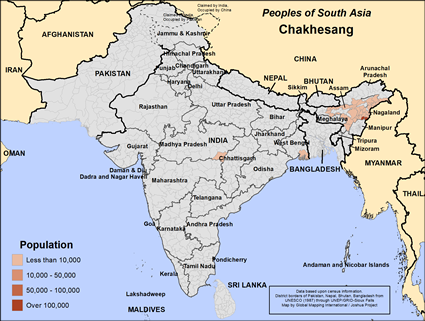Chakhesang in India

Photo Source:
Copyrighted © 2025
Kerry Olson All rights reserved. Used with permission |

Map Source:
People Group data: Omid. Map geography: UNESCO / GMI. Map Design: Joshua Project.
|
| People Name: | Chakhesang |
| Country: | India |
| 10/40 Window: | Yes |
| Population: | 158,000 |
| World Population: | 158,000 |
| Primary Language: | Naga, Chokri |
| Primary Religion: | Christianity |
| Christian Adherents: | 99.26 % |
| Evangelicals: | 0.00 % |
| Scripture: | New Testament |
| Ministry Resources: | Yes |
| Jesus Film: | Yes |
| Audio Recordings: | Yes |
| People Cluster: | South Asia Tribal - Naga |
| Affinity Bloc: | South Asian Peoples |
| Progress Level: |
|
Introduction / History
Chakhesangs are one of the Naga tribes of northeastern India. The name "Chakhesang" is an acronym derived from three subgroups: Chokri, Khezha, and Sangtam. They speak Chokri Naga.
What Are Their Lives Like?
Chakhesangs are subsistence farmers who grow rice, beans, corn, millet, and vegetables. They get their meat from chickens, from hunting, and fishing. The latter two are becoming less available due to environmental limitations. They earn cash by selling handmade bamboo and cane goods. Women make and sell woven goods.
Families arrange marriages through negotiations between family leaders. They must not marry someone from their own clan. Wedding ceremonies include singing, dancing, and feasting. Everyone in the village participates. Their wedding practices changed when they became Christian.
What Are Their Beliefs?
Traditionally animistic, most are now Christian, especially Baptist.
What Are Their Needs?
Chakhesangs need education so they can get higher-paying jobs. Their youth are migrating to cities, hoping to find better job opportunities, but they find their prospects are limited by attending rural schools.
Prayer Points
Pray for the Holy Spirit to do mighty works in Chakesang churches and families, spurring them on to love and good works.
Pray for their churches to send missionaries to Hindus and Tibetan Buddhists.
Pray for the Lord to provide them with the education they need to weather changes in the 21st century.